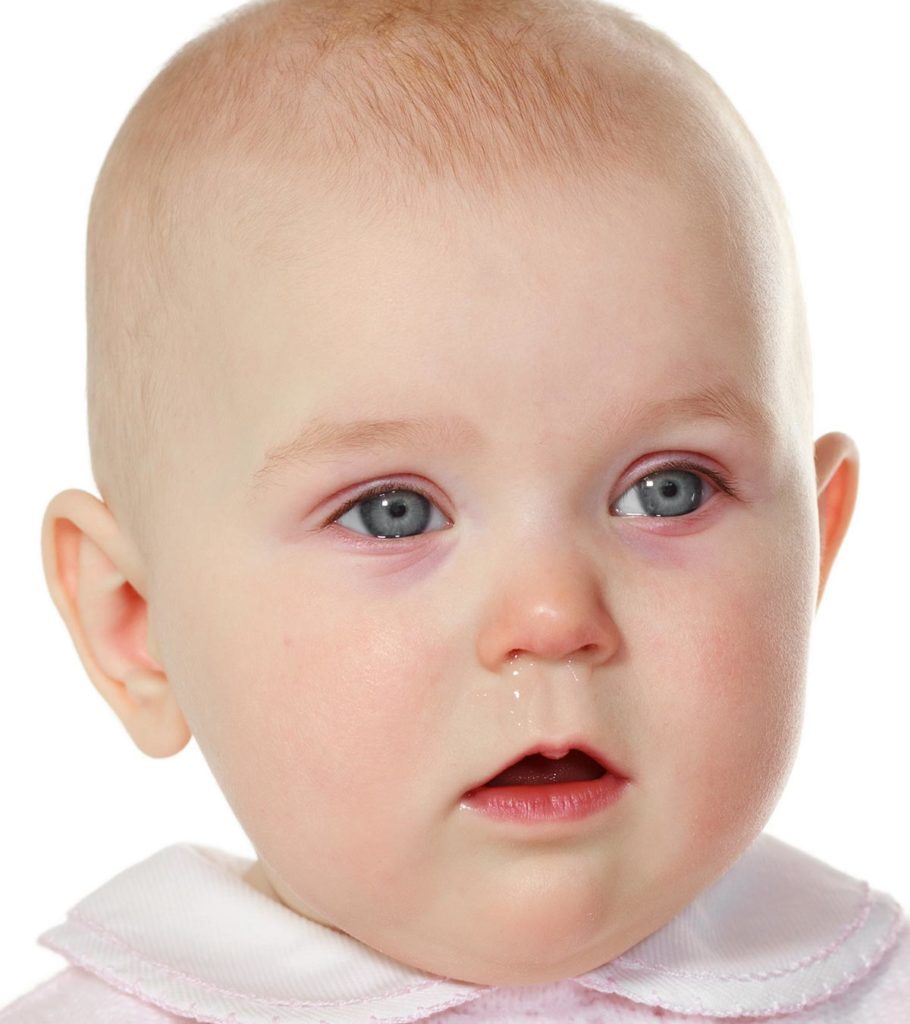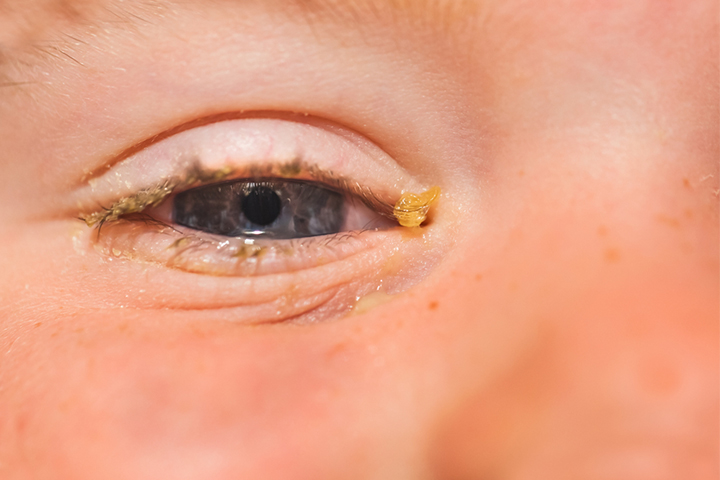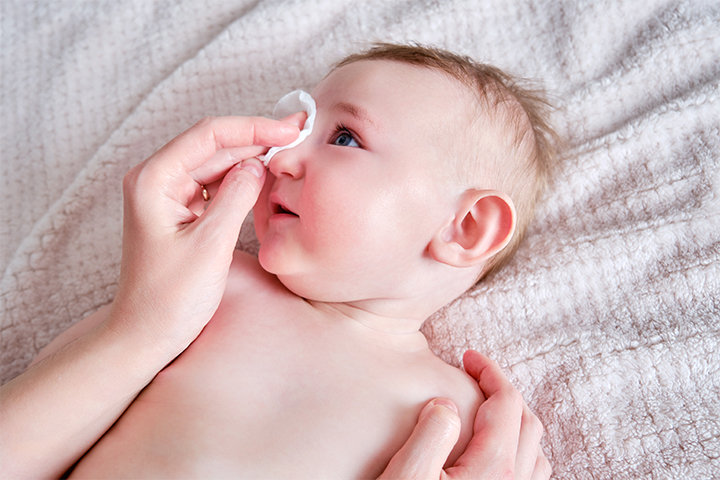Pink eye in babies may result from an infection or allergy and is referred to as conjunctivitis. According to StatPearls Publishing, infectious neonatal conjunctivitis is prevalent among 1% to 2% of newborns. Conjunctivitis often resolves by itself, and medical treatment is usually not required.
The best way to prevent the condition from affecting your baby’s eyes is by avoiding the causative factors. Continue reading this post as we describe the causes of pink eye in babies, its symptoms, diagnosis, treatment, and preventive measures.
What Is A Pink Eye In Babies?
A pink eye is the generic name for an eye infection called conjunctivitis (1). It is one of the most common eye infections to affect people of all age groups including infants and toddlers. The affected part is the conjunctiva, which is a thin layer of tissue covering the white of the eyes and also the inside of the eyes. Hence the name conjunctivitis.
What Causes Pink Eye In Babies?
According to the US Center for Disease Control and Prevention, there are four types of pink eye: viral, bacterial, irritant, and allergen. All four causes display similar symptoms and each category has several agents/pathogens that can lead to a pink eye:
- Viruses: Viral conjunctivitis often co-exists with the common cold (2). Adenovirus is the most common viral pathogen since it causes both cold and conjunctivitis (3). Herpes simplex is another virus that can cause pink eye. Viral pink eye is less common among newborn babies, but older toddlers are susceptible to it (4).
- Bacteria: Numerous bacterial infections may lead to a pink eye. The most common ones are Staphylococcus aureus (Staph infection bacterium), Streptococcus pneumoniae (Pneumonia bacterium), and Haemophilus influenzae (Influenza bacterium) (5). Bacterial conjunctivitis is more common among newborns who are a few days to weeks old.
- Irritants: Smoke, dust, and fumes of chemicals are common causes for irritant conjunctivitis.
- Allergens: Allergic conjunctivitis occurs due to the body’s reaction to an allergen, which is a substance that can cause allergy. Examples of allergens are pollen, dust mites, molds, pet dander, and some medicines. Allergic conjunctivitis is usually more common among infants with an existing allergic condition like eczemaiXA set of conditions that cause the skin to become inflamed, blistered, thick, crusty, and scalyand asthma.
When a newborn contracts conjunctivitis within the first 30 days of life due to the transmission of infection from the birth canal of a mother with a sexually transmitted disease, the condition is referred to as ophthalmia neonatorum.
While several factors could lead to pink eyes in babies, finding out the exact cause of it in babies is important to provide the right treatment.
Is Pinkeye Contagious?
Viral or bacterial pinkeye can be highly contagious. Viral conjunctivitis is spread through hand-to-eye contact, by objects contaminated with the virus, or by large respiratory droplets.
Bacterial conjunctivitis may spread through hand-to-eye contact, contaminated object to eye contact, a vertical transmission (from mother to baby during childbirth), or by large respiratory tract droplets (6) (7).
How Does A Baby Get Pink Eye?
Certain risk factors can increase an infant and toddler’s risk of acquiring the pink eye infection. They include:
- Catching the pathogen from someone: A family member with a pink eye or cold can pass the pathogen to the infant by holding them with contaminated hands.
- Touching eyes with dirty hands: Toddlers returning from outdoor play may rub their eyes with their dirt-laden hands and spread an irritant like pollen or a pathogen. Babies with cold may put hands in their mouth and then touch their eyes.
- Seasonal changes: There could be more pollen or dust in the air during certain seasons, which increases the likelihood of developing allergic conjunctivitis.
- Lifestyle: A baby could be allergic to the family pet, medicine, or to a plant in the surroundings – all of which can contribute to irritant and allergic conjunctivitis.
- Spending a lot of time at daycare: Infants and toddlers at daycares are always at a higher risk of getting several illnesses including pink eye. Transmission of a pathogen is faster in a crowded setting.
There are several ways your little one can get conjunctivitis. It is thus essential to know how to spot the symptoms.
Early Signs Of Conjunctivitis Infection
Some signs of impending conjunctivitis can be identified before the eye changes its color to pink. At times, baby pink eye may occur immediately after an episode of a viral ear or throat infection. Babies might exhibit the following signs before the eye becomes pink:
- Swollen or puffy eyelids
- Reddish discoloration of the eyelids
- Watery eyes
- Frequent rubbing of the eyes
- Sticky discharge from eyes or crust formation
- Increased irritability
- Increased sleepiness
- Reduced laziness
- Increased clinginess
- Reduced appetite
- Diarrhea or constipation
What Are The Symptoms Of Pink Eye In Babies?
A baby with conjunctivitis displays the following symptoms (8):
- Eye redness: Inflammation of the conjunctiva causes the blood vessels to become prominent and hence more visible across the white of the eye. The white of the eye has a pinkish-red tint and the blood vessels are noticeable. Viral conjunctivitis often begins with one eye and later spreads to the other one.
- Excessive tearing: The eyes get watery due to surplus production of tears. Watery discharge from the eyes is more common in viral conjunctivitis.
- Irritation, burning, and feeling of a foreign body: The eyes feel irritated, sore, and have a constant burning sensation. Older toddlers may feel and complain about ‘something getting into their eyes’.
- Intense itching: The infant would rub their eyes frequently to ease the itching and eye irritation. Intense itching can be more common when the cause of pink eye is an allergy.
- Swelling of the conjunctiva: The eye appears swollen within the socket. It is due to the inflammation of the conjunctiva.
- Pus within eyelids: Pus is more common in bacterial conjunctivitis. Excess pus may ooze from the corner of the eyes.
- Crusty eyelashes: Eyelashes develop a layer of crust especially in the mornings. It can be more common when the baby also has pus, which dries overnight and forms crusts by morning.
- Trouble opening eyelids: If the baby has pus and crusting of eyelids, then they will also have trouble keeping their eyelids open. Eyelids will appear sticky with the pus discharge stretching out between the eyelids.
How Is A Pink Eye Diagnosed?
Doctors use the following steps for the diagnosis of conjunctivitis in infants:
- Eye examination: Your doctor will examine your eyes for symptoms such as redness of the eye and eye inflammation (inflamed conjunctiva). Other factors, including the ability to open your eyelids and clear or blurry vision, will also be evaluated.
- Associated symptoms: Viral conjunctivitis is often accompanied by a common cold, while an ear infection mostly accompanies pink eye due to bacteria. Checking for the other associated symptoms can give the doctor a lead and help in better diagnosis.
- Blood test: A laboratory blood test checks for virus, bacteria, and antibodies that tells the doctor about the precise nature of the underlying infection. But, generally, it is not required.
A proper diagnosis at a pediatric ophthalmology unit is followed by a course of treatment, which depends on the underlying cause.
How Is The Pink Eye In Infants Treated?
In most cases, conjunctivitis goes away on its own and treatment is rarely needed. Certain steps, however, help ease the symptoms and accelerate the rate of healing. Treatment options include (9) (10):
- Antibiotic eye drops: Antibiotic eye drops and ointments can only work in the case of bacterial conjunctivitis. Whether or not antibiotics are effective against bacterial conjunctivitis is not known, although small quantities of antibiotics help shorten the course of infection (11).
Recalling the moment when she encountered the beginning stages of pink eye in her infant, Julia, a mother of four, says, “The kids and I all had colds last week. Nothing too bad, really, until Porter woke up from his afternoon nap on Thursday with a red, disgusting, goopy eye. He woke up Friday morning with both eyes just not right. At all. I won’t even discuss the amount of gunk coming out of his eyes and nose, but it was horrifying, and I knew I had to take him to the doctor.
“Verdict: probably pink eye. And it’s probably viral. But just in case, we got antibiotic eye drops to treat it. He seemed as good as new within twelve hours of starting the eye drops. Putting the ointment in his eyes four times per day for a week was pretty awful, but at least he seems to have always felt like his normal, happy self (i).”
Always use the antibiotics in the prescribed quantity to prevent overdose and develop antibiotic resistance. Visit the doctor before using antibiotic eye drops. Most infants show an improvement in 2-6 days without antibiotic treatment for bacterial conjunctivitis.
- Antiviral eye drops: The body’s immune system clears away the virus causing viral conjunctivitis. However, if the infection is severe, then the doctor may prescribe antiviral eye drops. These drops usually work against potent viruses like herpes simplex. Viral conjunctivitis can take a week to two weeks to go away but may extend beyond two weeks if the pink eye infection is severe.
- Clearing the allergen/irritant off the eye: Wash your hands with soap, dry them, and use a sterile cotton ball to remove a visible allergen from the baby’s eyes gently. If the allergen is too small or lodged deep within the eye, then do not attempt removal and consult a doctor right away.
You can wash the allergen using water in the case of older toddlers. Make sure to keep your hands clean and use clean water, preferably clean drinking water. Pour the water gently over the eye to rinse the allergen away. If the child does not get relief, then consult the doctor.
How Can Parents Help?
Adults with conjunctivitis often use cold compresses and saline drops for the eyes. However, such infection management techniques may not be safe for a baby. Some mothers may pour a small quantity of breast milk into the infected eye of the infant. But there is no scientific evidence that breast milk is an effective cure for conjunctivitis in babies. Instead, some research suggests that breastmilk can introduce conjunctivitis causing bacteria into the eyes (12). Maintain good eye hygiene for babies, and do not try home remedies without consulting your doctor.
It is best to avoid any home remedies for your baby’s pink eyes since we do not know how the infant’s eye would respond to them. If the eyes get too watery or sticky, use a sterile gauze cotton swab to clean them gently. The doctor can prescribe an antiseptic liquid to soak the gauze cotton swab in it before cleaning the eyelid. Always clean externally and never inside the eye. Do not use a cotton wool ball as cotton fibers can get into the eyes (13).
Can Pink Eye Become More Serious?
In most cases, conjunctivitis does not pose a serious threat. However, conjunctivitis in a newborn can be severe and needs immediate medical attention (14).
Rarely, conjunctivitis may pose a serious threat to overall health. Severe and untreated eye allergies caused by conjunctivitis may lead to irreversible scarring in the eye. Rarely, infectious conjunctivitis may spread to other body parts and lead to secondary infections such as meningitis (15).
Complications can be pervasive among infants with immunosuppressiveiXSuppression of the body’s immunological response and capacity to fight against infectionsdiseases, such as HIV/AIDS or cancer. Pink eye in babies is mostly a self-limiting infection that resolves without any complications (16). Nevertheless, prevention is always the best option.
How To Prevent Pink Eyes In Babies?
Preventing pink eye in babies is like avoiding any other illness. Here is what you must do to protect your child from conjunctivitis (6):
- Maintain hygiene: Keep your baby’s surroundings and personal items clean. Ask your toddler to wash their hands every time they come home from outdoors. Also, teach them never to rub their eyes with fingers.
- Avoid allergens and irritants: If your baby has allergies, then take adequate steps to prevent exposure to potential allergens. Keep the baby away from chemicals, automobile exhaust fumes, and other potential airborne irritants.
- Avoid contact with those infected: Keep baby away from family members who are unwell with infections like the common cold. If the mother has an infection, then she must wash her hands before handling the baby. Wear a face mask while breastfeeding the baby to prevent the transfer of pathogens.
- Vaccinate: Get the child vaccinated for some common viral infections such as influenza and pneumonia bacteria that can cause pink eyes.
Signs You Should Call the Doctor
The following signs in a baby with conjunctivitis indicate the need to see a doctor (9) (17):
- Signs does not improve or worsen even after two days
- Increasing eye swelling, pain, or redness around the eyelids or surrounding the eyes
- Persistent fever
- A white spot in the front of the eye
- Increased sensitivity to light
- Pus or mucus discharge from the eyes
Conjunctivitis or pink eye in infants or babies can be caused by viruses, bacteria, or allergens and transmitted when in contact with an infected person. The symptoms of pink eye, such as red eyes and excessive tear production, usually resolve on their own. However, doctors usually prescribe eye drops and eyewashes to assist the recovery. It is advised to refrain from trying any home remedies to treat conjunctivitis in babies unless your doctor has approved them. Further, vaccinate your child and maintain proper hygiene to avoid exposing your child to such infections.
Key Pointers
- Pink eye (conjunctivitis) is an infection of a layer of the eye.
- It is a contagious disease that can spread through viruses, bacteria, irritants, or allergens.
- Contact with an infected person and poor hygiene can increase the risk of contracting the disease.
- Symptoms of conjunctivitis include burning, swelling, pus, redness, and watery eyes.
- Regular hand-washing, vaccinations, and avoiding exposure to allergens can help prevent pink eye in babies.
- Medical professionals can treat it with the help of antibiotic or antiviral eye drops, which are available over the counter.
Explore this video resource to gain comprehensive knowledge about pink eye, including its causes and available treatment options for effective infant care.















